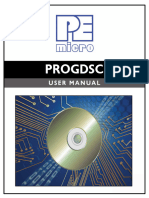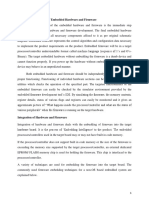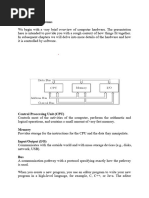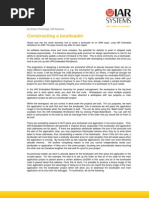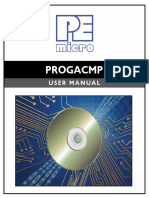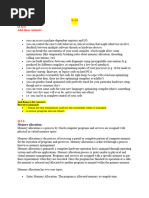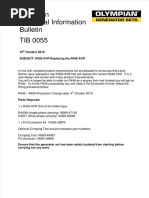In Circuit Flash Programming
In Circuit Flash Programming
Uploaded by
Satyanarayana Reddy KarriCopyright:
Available Formats
In Circuit Flash Programming
In Circuit Flash Programming
Uploaded by
Satyanarayana Reddy KarriOriginal Description:
Copyright
Available Formats
Share this document
Did you find this document useful?
Is this content inappropriate?
Copyright:
Available Formats
In Circuit Flash Programming
In Circuit Flash Programming
Uploaded by
Satyanarayana Reddy KarriCopyright:
Available Formats
In-Circuit Flash Programming Flash programming solutions are designed to program target memory in-circuit.
This includes both internal memory on a Free scale processor and external flash connected to the processor's address/data bus. These solutions give the user the option of mounting the processor or memory device on the final printed circuit board before programming it. The programming itself is accomplished via a simple header on the board that is connected to certain pins on the processor. P&E's programming hardware connects to this header to allow program, test, and debug of the target microcontroller and any memory which is attached to it. The example is a PC-controlled Cyclone PRO (stand-alone programmer) that is connected to a device under test. During product development, engineers will often program the same target processor many times with different versions of code. The engineer may want to interactively access the memory, protect it, unprotect it, erase it, view it, modify the contents, etc. However, it may also be useful to program the target automatically with a single click of the mouse or keyboard. Both methods are supported by P&E's development tools. Two P&E products are used to program the target: flash programming software (PROG), and a hardware interface connecting the PC to the target processor. Hardware Interface P&E offers several different target interfaces according to the user's requirements. The interfaces fall into three general categories
Cyclone PRO/MAX Stand Alone programmers (supporting serial port, USB, and Ethernet) Parallel Port Interface Cable USB Multilink Cable
Flash Programming Software (PROGxxZ) The Flash programming software allows the user to erase, program, and verify either internal processor flash or external flash connected on the processor's address/data bus. The flash programmer comes with a host of programming algorithms for different memory configurations.
Cyclone PRO/MAX - Stand-Alone Configuration
The Cyclone PRO/MAX stand-alone programmers are designed to be loaded with an image which will later be programmed into the target microcontroller. This means that large volumes of data do not have to be transferred from the PC. Instead, they only need to take one step from the Cyclone PRO/MAX to the target. The programming image contains the data to be programmed, the devicespecific programming algorithm, and the steps to be taken during programming and verification. The Cyclone PRO/MAX stores the programming image in its internal flash so that it will be retained even without power. The programming process may be initiated from a host computer, or manually by an operator (with no computer required). New programming images may be downloaded into the Cyclone PRO/MAX either manually or automatically via P&E command line utilities.
You might also like
- A. Schulz - Architectural PhotographyDocument235 pagesA. Schulz - Architectural PhotographyWievv pad100% (1)
- 6 Pulse ConverterDocument19 pages6 Pulse Converterfalu_2964% (11)
- PROGDSC User ManualDocument35 pagesPROGDSC User ManualpppppppivanovNo ratings yet
- Embedded SystemsDocument11 pagesEmbedded Systemsapi-3827000No ratings yet
- Embedded Systems and Information AppliancesDocument11 pagesEmbedded Systems and Information Appliancesshaikshaa007100% (4)
- USB Flash ProgrammingDocument10 pagesUSB Flash Programmingv.syroiezhinNo ratings yet
- Embedded Systems and InformDocument11 pagesEmbedded Systems and InformJerin JoseNo ratings yet
- CS404 EM Module 4 1Document20 pagesCS404 EM Module 4 1T.RohitNo ratings yet
- 2.tutorial 1 - Implementation of A USB Based PIC-To-PC CommunicationDocument30 pages2.tutorial 1 - Implementation of A USB Based PIC-To-PC CommunicationMurat Şen100% (1)
- Ment NagaDocument73 pagesMent NagaNani NRajNo ratings yet
- Development Process of Embedded SystemsDocument7 pagesDevelopment Process of Embedded SystemsSruthi Reddy100% (1)
- Current and Future Development of Open Source Software and Latest Development in IctDocument10 pagesCurrent and Future Development of Open Source Software and Latest Development in IctNur SyamimieNo ratings yet
- Micrex SX D300 Win Programing Tool LEH982f - Expert - Ver2Document4 pagesMicrex SX D300 Win Programing Tool LEH982f - Expert - Ver2Sting EyesNo ratings yet
- Seven Steps To Embedded Designs Made Easier With Psoc CreatorDocument3 pagesSeven Steps To Embedded Designs Made Easier With Psoc Creatorsree2728No ratings yet
- CCCCCC CDocument60 pagesCCCCCC CSanthan ManneNo ratings yet
- Annexure For Beeprog+Document4 pagesAnnexure For Beeprog+Mdd Papis0% (1)
- I Unit Ia NotesDocument4 pagesI Unit Ia NotesSathyashree ManojNo ratings yet
- Unit Iii General Purpose Processor Software DevelopmentDocument11 pagesUnit Iii General Purpose Processor Software DevelopmentSaritha ReddyNo ratings yet
- PROGCFZ User ManualDocument40 pagesPROGCFZ User ManualpppppppivanovNo ratings yet
- NozzleFEM-System Administrator Guide EngDocument4 pagesNozzleFEM-System Administrator Guide Enger_scecNo ratings yet
- Programming Design ToolsDocument17 pagesProgramming Design ToolsesantiagosaavedraNo ratings yet
- Embedded SystemDocument7 pagesEmbedded SystemSoundarya SvsNo ratings yet
- CX ONE V2.0 FuncionesDocument5 pagesCX ONE V2.0 FuncionesOmar CortesNo ratings yet
- Upgrading Embedded Design Firmware Via USBDocument5 pagesUpgrading Embedded Design Firmware Via USBreemaroy08100% (1)
- Debugging Tools ForDocument10 pagesDebugging Tools ForVijay Kumar KondaveetiNo ratings yet
- Basic Organization of A Computer SystemDocument6 pagesBasic Organization of A Computer SystemNadeem AhmedNo ratings yet
- Overview On Application Development and Emerging TechnologiesDocument5 pagesOverview On Application Development and Emerging TechnologiesKent DivinagraciaNo ratings yet
- Progcfv1 User ManualDocument39 pagesProgcfv1 User ManualpppppppivanovNo ratings yet
- Wireless Keyboard & Mouse EmulatorDocument84 pagesWireless Keyboard & Mouse EmulatorVijitha KalassNo ratings yet
- Computer SubsystemsDocument2 pagesComputer SubsystemsShashank Singh RathourNo ratings yet
- PROGPPCZ User ManualDocument39 pagesPROGPPCZ User ManualpppppppivanovNo ratings yet
- Embedded System TaskDocument10 pagesEmbedded System TaskmohamedabuhibsNo ratings yet
- In Circuit EmulatorDocument6 pagesIn Circuit EmulatorJeeva Bharathi0% (1)
- Lab 1 1Document15 pagesLab 1 1Malak Al-AshiNo ratings yet
- Bioelex Pr5Document28 pagesBioelex Pr5Eagle CoolNo ratings yet
- Lab Manual DSP (2020)Document68 pagesLab Manual DSP (2020)Ch UsamaNo ratings yet
- Cross Assembler: Language) - The Original Sequence Is Usually Called The Source Code and The OutputDocument9 pagesCross Assembler: Language) - The Original Sequence Is Usually Called The Source Code and The Outputhub23No ratings yet
- Constructing A BootloaderDocument3 pagesConstructing A BootloaderSameel Kollam100% (2)
- Keil IDEDocument5 pagesKeil IDEAnkit AgrawalNo ratings yet
- Lab01 MP PDFDocument11 pagesLab01 MP PDFAlicia KohNo ratings yet
- Statistical Analysis With Software Application: Presented by BSMA 2-4Document68 pagesStatistical Analysis With Software Application: Presented by BSMA 2-4azy delacruzNo ratings yet
- Chapter 1Document7 pagesChapter 1V KumarNo ratings yet
- PROGACMP User ManualDocument52 pagesPROGACMP User ManualpppppppivanovNo ratings yet
- Fpga: Digital Designs: Team Name:Digital DreamersDocument8 pagesFpga: Digital Designs: Team Name:Digital DreamersRishabhNo ratings yet
- 1505901474lect37 (1Document6 pages1505901474lect37 (1Sharmila DeviNo ratings yet
- UM01041 embOS CortexM CypressDocument44 pagesUM01041 embOS CortexM CypressSmart ClasseNo ratings yet
- PE3359 - Technical Summary For USB-ML-1632Document5 pagesPE3359 - Technical Summary For USB-ML-1632Henry A Ramirez CNo ratings yet
- Micro HopeDocument48 pagesMicro Hopeviolator100% (1)
- Programming PIC Microcontrollers in CDocument126 pagesProgramming PIC Microcontrollers in CShomeswaran Mugunthan100% (3)
- Software Details: For The Designing and Development of The Project We Use Different Types of Software's. They AreDocument15 pagesSoftware Details: For The Designing and Development of The Project We Use Different Types of Software's. They AreratheeshbrNo ratings yet
- Q-1 (A) Add These Contents:-: Memory AllocationDocument2 pagesQ-1 (A) Add These Contents:-: Memory Allocationmasow50707No ratings yet
- E and IOT LAB Usermanual - MLR 20 With M - PythonDocument117 pagesE and IOT LAB Usermanual - MLR 20 With M - PythonShiva reddyNo ratings yet
- Embedded ProgrammingDocument53 pagesEmbedded ProgrammingRAJINo ratings yet
- Part 1 BCCDocument47 pagesPart 1 BCCKyla FlorNo ratings yet
- Beeprog2C: (Ord - No. 60-0059)Document7 pagesBeeprog2C: (Ord - No. 60-0059)hariz harizNo ratings yet
- Software Suite: Revolutionizing Computer Vision with the Ultimate Software SuiteFrom EverandSoftware Suite: Revolutionizing Computer Vision with the Ultimate Software SuiteNo ratings yet
- Computer Science: Learn about Algorithms, Cybersecurity, Databases, Operating Systems, and Web DesignFrom EverandComputer Science: Learn about Algorithms, Cybersecurity, Databases, Operating Systems, and Web DesignNo ratings yet
- The Software Programmer: Basis of common protocols and proceduresFrom EverandThe Software Programmer: Basis of common protocols and proceduresNo ratings yet
- NECA 402: Standard For Installing and Maintaining Motor Control CentersDocument42 pagesNECA 402: Standard For Installing and Maintaining Motor Control CentersGILBERTO ALTUNARNo ratings yet
- 901 Cpu Book Cp3 Cpu enDocument167 pages901 Cpu Book Cp3 Cpu enSandigai MariosNo ratings yet
- R450M and R450T AvrDocument7 pagesR450M and R450T Avrfahad pirzadaNo ratings yet
- Document PDFDocument16 pagesDocument PDFnelson_herreraNo ratings yet
- OBD AT Commnads ELM327DS PDFDocument94 pagesOBD AT Commnads ELM327DS PDFclick2klic100% (1)
- Magic Sine ChipDocument11 pagesMagic Sine ChipgokerarNo ratings yet
- Microcprocessors and Microcontrollers LabDocument1 pageMicrocprocessors and Microcontrollers Labkskumargie0% (1)
- Cde 500Document60 pagesCde 500javierNo ratings yet
- Trsm0930en-Us 0215Document156 pagesTrsm0930en-Us 0215AnGel Amaya100% (1)
- Answer: Control System (Unit 1)Document18 pagesAnswer: Control System (Unit 1)Ajeet Kumar shuklaNo ratings yet
- Seminar On Voip: Presented byDocument15 pagesSeminar On Voip: Presented bySubir MaityNo ratings yet
- Mrudang Kadakia Computer Parallel Port InterfacingDocument5 pagesMrudang Kadakia Computer Parallel Port Interfacingapi-225150159No ratings yet
- AS400 Basics ManualDocument16 pagesAS400 Basics ManualNarin RattanakulNo ratings yet
- Chapter 1Document36 pagesChapter 1Umesh ChandraNo ratings yet
- Model:: Generator SpecificationDocument4 pagesModel:: Generator SpecificationWILMAR ANDRES SANCHEZ TORRESNo ratings yet
- Some Interesting Technical Approaches) Just Scroll Down ThisDocument8 pagesSome Interesting Technical Approaches) Just Scroll Down ThisAbdul Hamid KurniawanNo ratings yet
- S30D45CDocument3 pagesS30D45CSujit ChatterjeeNo ratings yet
- DABDocument51 pagesDABFernando Sobrino-Manzanares MasNo ratings yet
- EE 365 Assignment #1: Print Out Assignment and Do Work On The Printed PagesDocument5 pagesEE 365 Assignment #1: Print Out Assignment and Do Work On The Printed PagesEesha SajidNo ratings yet
- History of DronesDocument11 pagesHistory of DronesVaibhav SharmaNo ratings yet
- MPD 600 Self Test: Application NoteDocument7 pagesMPD 600 Self Test: Application NoteInsan AzizNo ratings yet
- Hiper VR: Versatile Gnss ReceiverDocument4 pagesHiper VR: Versatile Gnss ReceiverysandroNo ratings yet
- Electrical Machines - II - by Er - NirajkandelDocument122 pagesElectrical Machines - II - by Er - NirajkandelNIRAJ KANDEL100% (2)
- 7 SegmentDocument16 pages7 SegmentAsin PillaiNo ratings yet
- C441 Ethernet Module User ManualDocument68 pagesC441 Ethernet Module User ManualFlo MircaNo ratings yet
- Digital Filter Design - 2ndDocument17 pagesDigital Filter Design - 2ndilaNo ratings yet
- Ek307 f17 hw5 SolnDocument13 pagesEk307 f17 hw5 SolnHồng TrầnNo ratings yet
- Inorganic Chem Test 1Document3 pagesInorganic Chem Test 1BoopathiMalarNo ratings yet


